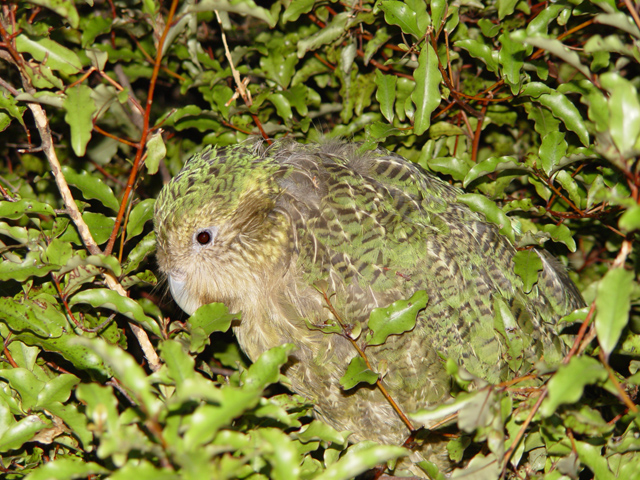Kakapo (Strigops habroptilus) - Wiki Kakapo
From Wikipedia, the free encyclopedia
[Photo] Kakapo Pounamu, showing how the bird's plumage acts as camouflage in vegetation. German description: Der Kakapo Pounamu, gut getarnt in einem Geb??sch. Photo taken on Codfish Island (Whenua Hou), New Zealand. Date 21.12.2005. Author Mnolf http://commons.wikimedia.org/wiki/User:Mnolf
The Kakapo (M??ori: k??k??p??, meaning night parrot), Strigops habroptilus (from the Greek strix, genitive strigos: owl and ops: face; and habros: soft, and ptilon: feather), also called owl parrot, is a species of nocturnal parrot with finely blotched yellow-green plumage endemic to New Zealand.[1] It has a distinct facial disc of sensory, vibrissa-like feathers, a large grey beak, short legs, large feet, and wings and a tail of relatively short length. A certain combination of traits makes it unique among its kind???it is the world's only flightless parrot, the heaviest parrot, nocturnal, herbivorous, it sports visible sexual dimorphism in body size, has a low basal metabolic rate, no male parental care, and is the only parrot to have a polygynous lek breeding system. It is also possibly one of the world's longest-living birds.[2] Its anatomy typifies the tendency of bird evolution on oceanic islands with few predators and abundant food: accretion of thermodynamic efficiency at the expense of flight abilities, reduced wing muscles, a diminished keel on the sternum, a generally robust physique.[2]
Kakapo are critically endangered; only 86 living individuals are known, all of which have been given names.[3] The ancestral Kakapo migrated to the islands of New Zealand in prehistory; in the absence of mammalian predators, it lost the ability to fly. Because of Polynesian and European colonisation and the introduction of predators such as cats, rats, and stoats, most of the Kakapo were wiped out. Conservation efforts began in the 1890s, but they were not very successful until the implementation of the Kakapo Recovery Plan in the 1980s. As of November 2005, surviving Kakapo are kept on four predator-free islands, Maud, Chalky (Te Kakahu), Codfish (Whenua Hou) and Anchor islands, where they are closely monitored.[2] Two large Fiordland islands, Resolution and Secretary, have been the subject of large-scale ecological restoration activities to prepare self-sustaining ecosystems with suitable habitat for the Kakapo.
The conservation of the Kakapo has made the species well known. Many books and documentaries detailing the plight of the Kakapo have been produced in recent years, one of the earliest being Two in the Bush, made by Gerald Durrell for the BBC in 1962.[4] Two of the most significant documentaries, both made by NHNZ, are Kakapo - Night Parrot (1982) and To Save the Kakapo (1997). The BBC's Natural History Unit also featured the Kakapo, including a sequence with Sir David Attenborough in The Life of Birds. It was also one of the endangered animals that Douglas Adams and Mark Carwardine set out to find for the radio series and book Last Chance to See.
The Kakapo, like many other bird species, has historically been important to the M??ori, the indigenous people of New Zealand, appearing in many of the traditional legends and folklore.
...
http://en.wikipedia.org/wiki/Kakapo
| The text in this page is based on the copyrighted Wikipedia article shown in above URL. It is used under the GNU Free Documentation License. You may redistribute it, verbatim or modified, providing that you comply with the terms of the GFDL. |
